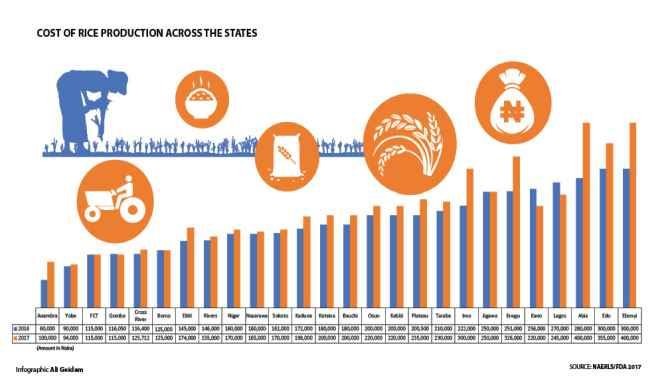
The cost of rice production went up significantly in the last two years, a recent survey released by the Federal Government has shown.
The year 2016 was a difficult one for farmers because of the high cost of inputs like fertilizer, which sold as high as N12,000 per bag in some places. This is said to be due to government’s restriction on the sale of urea fertilizer, a basic ingredient for making explosives by insurgents in the North East.
The situation left many farmers unable to buy the product in most parts of the North, which is the largest consumer of fertiliser.
Although the year was goodfor farmers in the country as they got good prices for their produce, the cost involved in every aspect of production nullified that gain. This is also worsened by the weakened value of the naira against the dollar as a result of the economic recession.
Two weeks ago, the Minister of State for Agriculture and Rural Development, Dr. Heineken Lokpobiri, unveiled for the first time in 30 years, the National Agricultural Performance Survey for the 2017 wet season in Nigeria.
The survey was done by the National Agricultural Extension and Research Liaison Services (NAERLS) Ahmadu Bello University, in collaboration with the Federal Department of Agriculture and the Federal Department of Extension Services.
The report has presented a lot of data regarding the various subsectors of the nation’s agriculture which were hitherto inaccessible to the general public.
The National Agricultural Performance Survey for rice compares the cost of production in 2016 to 2017 thus: “The 2017 wet season survey showed that the estimated cropped area for rice was 3.90 hectares, which represented an increase of about 6.9 per cent over the 3.17 per cent hectares cultivated in 2016.
“The increase in land area could be attributed to the Federal Government’s initiatives of reducing the large sums of money used for the importation of the crop and the intensification of the production of the crop in the country.
“A total output of 8.02 million metric tonnes was recorded in 2017 as against the 6.99 million tonnes recorded in 2016, which indicated that the crop had recorded a significant increase in the output of about 14.7 per cent.
However, the average yield of 2.4 per cent recorded is still far below global standard,” the report reads in part.
While the quantum of rice production has increased in the country; thanks to good prices, import restriction and the Anchor Borrowers’ Programme of the Central Bank of Nigeria, the cost of production has gone up by more than 50 per cent in some states.
For instance, Anambra State, which has the least cost for producing rice per hectare, recorded 40 per cent increase from N60,000 in 2016 to N100,000 in 2017; whereas the cost in Abia and Ebonyi States rose from N280,000 and N300,000 respectively to N400,000.
In 2016, the cost of major farm operations across the 36 states and the FCT indicated that ploughing a hectare was N16, 739.8, but was increased to N20, 196.4 in 2017, while harrowing rose from N14,265.6 to N17, 589.2 per hectare in 2017.
An Agricultural Economist, Austin Bako, said the fall of the value of the naira against the dollar increased the prices of imported agro-machines and the raw materials for making fertilizer, chemicals and other inputs – something which he said also triggered the rise in the prices of these inputs.
Mr. Bako said the country had over the years relied heavily on imported machines for farm operations without giving due attention to some of the indigenous technologies that were developed by our research institutes.
Engineer James David of the National Centre for Agricultural Mechanisation (NCAM), in a chat, said the institute had large stock of indigenous technologies, which states government could leverage on for the benefit of their farmers.
Engr. David stressed that Nigerian farmers who were mostly smallholders would benefit greatly from these cheap technologies at the institute located in Ilorin, the Kwara State capital.
He said the institute could produce any machine that would increase the productivity of the farmers but noted that the politicians preferred to spend money heavily on imported ones.
Experts believe if government embarks on a deliberate programme to develop local technologies, which are key for mechanised farming, it will increase the productivity of an average Nigerian farmer.
Although, the Anchor Borrowers’ Programme seeks to remove the huge burden of cost from many rice farmers across the country, less than one million of the 12 million registered rice farmers accessed the funds, while many more millions of both registered and unregistered farmers are still struggling to benefit from the system.
The CBN’s Anchor Borrowers’ Programme must be expanded massively along with some government financial intervention to ease this cost until the country recovers completely from the shock of the last recession. It remains the viable way farmers can expand production and increase their output across the rice value chain.




